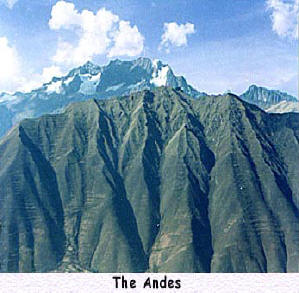|
||||||
|
Cities and Tourist attractions
Lima Lima, Peru's capital, is overcrowded, polluted, noisy and often has wretched weather. Nevertheless, the inhabitants are friendly and hospitable, opportunities for dining and nightlife are ample and the city has a great selection of museums. A project is now underway to restore the city's colonial center, so Lima may be a lot lovelier in the near future.
Attractions include the Museo de Arte, which exhibits colonial furniture and pre-Columbian artifacts as well as 400 years of Peruvian art, and the Museo Nacional de Antropología y Arquelogía, noted for its excellent exhibits of prehistoric Peru. Churches such as San Francisco (famous for its catacombs) and Santo Domingo (circa 1540) provide a welcome respite from the outside clamor. Lima's many markets, including Polvos Azules, overflow with consumer goods and handicrafts. There are also plazas, lovely colonial buildings and a zoo. |
|
|
Inexpensive accommodation can be found in the city center. The suburb of Barranco has a number of cheap restaurants and live music venues and is very popular with backpackers. The suburb of Miraflores has the city's best stores, restaurants and nightspots.
South Coast The Panamerican highway hugs the coast and passes through many areas of interest south of Lima, including Pisco, an important fishing port (best known for its white grape brandy), used by travelers as a base to see the wildlife of the nearby Islas Ballestas and Península de Paracas. The area is of much historical and archaeological interest, with burial sites of the Paracas culture a major lure. Further south is the town of Nazca, known for its colorful and elaborate pottery and the world-famous Nazca Lines - huge geometric designs, mostly of animals and birds - which are thought to have been built between 900 BC and 600 AD. The designs are only visible from the air but there are numerous flights over the area for around US$50.
Arequipa & Lake Titicaca Nicknamed the 'white city', Arequipa is surrounded by spectacular mountains, including the volcano El Misti. A feature of the city is its many beautiful buildings made of a light-colored volcanic rock called sillar. The Convento de Santa Catalina, perhaps the most fascinating colonial religious building in the country, was, until recently, home to almost 450 nuns. Many of the city's beautiful colonial houses, such as Casa Ricketts, are now used as art galleries or museums. Accommodation and food is cheap and often provided in lovely locations. The Colca Canyon, arguably the world's deepest canyon, is a popular excursion from Arequipa.
Lake Titicaca, at 3820m (12,530ft), is the highest navigable lake in the world. At over 170km (105mi) long, it is also the largest lake in South America. Its altitude means the air is unusually clear and the azure waters particularly striking. Interesting boat trips can be made from Puno, the major port on the lake. The area is also known for its folk dances and huge herds of alpacas and llamas.
Cuzco The archaeological capital of the Americas and the oldest continuously inhabited city on the continent, Cuzco is now an important link in the South American travel network. Its legacy as the hub of the Inca empire is readily apparent: Most of the city streets are lined with Inca-built stone walls and crowded with Quecha-speaking descendants of the Incas. The city has magnificent repositories of colonial art such as the catedral (begun in 1559) and La Merced Church. There is also the Coricancha ruins, east of the city center, which were formerly covered with gold (the stonework is all that remains) and the Museo de Arqueológia, the interior of which is filled with metal and gold work, jewelery, pottery, textiles and mummies. Four other ruins - Sacsayhuamán, Qenko, Puca Pucara and Tambo Machay - are nearby.
West of Cuzco is Machu Picchu, the best-known and most spectacular site on the continent. Despite the relentless stampede of tourists (especially during the dry season months, June to September), this 'Lost City of the Incas' still retains an air of grandeur and mystery and is a 'must see' for any visitor to Peru.
Iquitos Iquitos (pop 400,000), Peru's largest jungle city and the Amazon Basin's largest settlement without road links, is connected to the outside world only by air and river. Founded in the 1750s by Jesuits, it would later become an oil and rubber boomtown. Today the tourist economy is increasingly the area's main focus. Iquitos' main attraction is as a civilized gateway to the Amazon and jumping-off point for jungle excursions.
Huaraz Area Huraz is the most important climbing, trekking and backpacking center in Peru. The city of Huaraz has been demolished several times by massive earthquakes and is therefore not particularly atractive. The surrounding mountains, however, are exceptionally beautiful, and many travelers come to Peru specifically to visit the Huaraz area.
The Andes around Huaraz offer a wide range of attractions, the most evident of which are the many permanently glaciated peaks jutting up to 6000m. The climbing and hiking season runs May to September. There are also glacial lakes and hot springs and Inca and pre-Inca archeological sites, most notably Chavín de Huántar. Parque Nacional Huascarán, established in 1975, protects a large chunk of the Cordillera Blanca. The city of Huaraz is a great base camp, with a multitude of hotels and guide services to choose from. |
|

